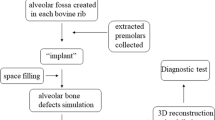Abstract
The purpose of this study was to investigate the possible effects of section thickness on volume estimations obtained by cone beam computed tomography. Intraosseal cavities representing bone defects on vestibular sides of the two dry sheep mandibles were scanned by a cone beam computed tomography system. Consecutive sections at 0.2, 0.6, 1, 1.4, and 2.2 mm thickness were used to estimate the volumes of the cavities using the Cavalieri principle of stereological methods. Estimated volumes are then compared with the volumes obtained by the Archimedean principle. In 0.2-, 0.6-, and 1-mm-thick slices, the volumes estimated by the Cavalieri principle did not differ from the volumes by the Archimedean principle (p > 0.05). The 0.2 mm slice-thickness group had the highest asymptotic significance value (p = 0.6). Although the thinnest slice appears to provide the most accurate values, slice thickness up to 1 mm can be chosen for volume calculations on CBCT images.



Similar content being viewed by others
References
Chau AC, Fung K: Comparison of radiation dose for implant imaging using conventional spiral tomography, computed tomography, and cone-beam computed tomography. Oral Surg Oral Med Oral Pathol Oral Radiol Endod 107:559–565, 2009
Loubele M, Bogaerts R, Van Dijck E, Pauwels R, Vanheusden S, Suetens P, Marchal G, Sanderink G, Jacobs R: Comparison between effective radiation dose of CBCT and MSCT scanners for dentomaxillofacial applications. Eur J Radiol 71:461–468, 2009
Sezgin OS, Kayipmaz S, Yasar D, Yilmaz AB, Ozturk M: comparative dosimetry of dental cone beam computed tomography, panoramic radiography, and multislice computed tomography. Oral Radiol 28:32–37, 2012
Kayipmaz S, Sezgin OS, Saricaoglu ST, Bas O, Sahin B, Küçük M: The estimation of the volume of sheep mandibular defects using cone-beam computed tomography images and a stereological method. Dentomaxillofac Radiol 40:165–169, 2011
Mouton PR: Principles and practices of unbiased stereology: An introduction for bioscientists. The Johns Hopkins University Press, Maryland, 2002, p 91
Roberts N, Puddephat MJ, McNulty V: The benefit of stereology for quantitative radiology. Br J Radiol 73:679–697, 2000
Mazonakis M, Damilakis J, Maris T, Prassopoulos P, Gourtsoyiannis N: Comparison of two volumetric techniques for estimating liver volume using magnetic resonance imaging. J Magn Reson Imaging 15:557–563, 2002
Sahin B, Alper T, Kokcu A, Malatyalıoğlu E, Kosif R: Estimation of the amniotic fluid volume using the Cavalieri method on ultrasound images. Int J Gynaecol Obstet 82:25–30, 2003
Acer N, Sahin B, Bas O, Ertekin T, Usanmaz M: Comparison of three methods for the estimation of total intracranial volume: stereologic, planimetric, and anthropometric approaches. Ann Plast Surg 58:48–53, 2007
Agbaje JO, Jacobs R, Maes F, Michiels K, van Steenberghe D: Volumetric analysis of extraction sockets using cone beam computed tomography: a pilot study on ex vivo jaw bone. J Clin Periodontol 34:985–990, 2007
Agbaje JO, Jacobs R, Michiels K: Abu-Ta’a M, van Steenberghe D. Bone healing after dental extractions in irradiated patients: a pilot study on a novel technique for volume assessment of healing tooth sockets. Clin Oral Investig 13:257–261, 2009
Deguchi Sr, T, Katashiba S, Inami T, Foong KW, Huak CY: Morphologic quantification of the maxilla and the mandible with cone-beam computed tomography. Am J Orthod Dentofacial Orthop 137:218–222, 2010
Bayram M, Kayipmaz S, Sezgin OS, Küçük M: Volumetric analysis of the mandibular condyle using cone beam computed tomography. Eur J Radiol 2011 (in press)
Liu Y, Olszewski R, Alexandroni ES, Enciso R, Xu T, Mah JK: The Validity of In Vivo Tooth Volume Determinations from Cone-Beam Computed Tomography. Angle Orthod 80:160–166, 2010
Star H, Thevissen P, Jacobs R, Fieuws S, Solheim T, Willems G: Human dental age estimation by calculation of pulp-tooth volume ratios yielded on clinically acquired cone beam computed tomography images of monoradicular teeth. J Forensic Sci 56:77–82, 2011
Tecco S, Saccucci M, Nucera R, Polimeni A, Pagnoni M, Cordasco G, Festa F, Iannetti G: Condylar volume and surface in Caucasian young adult subjects. BMC Med Imaging 10:28, 2010
Ogawa T, Enciso R, Shintaku WH, Clark GT: Evaluation of cross-section airway configuration of obstructive sleep apnea. Oral Surg Oral Med Oral Pathol Oral Radiol Endod 103:102–108, 2007
Sahin B, Mazonakis M, Akan H, Kaplan S, Bek Y: Dependence of computed tomography volume measurements upon section thickness: An application to human dry skulls. Clin Anat 21:479–485, 2008
Emirzeoglu M, Sahin B, Selcuk MB, Kaplan S: The effects of section thickness on the estimation of liver volume by the Cavalieri principle using computed tomography images. Eur J Radiol 56:391–397, 2005
Sahin B, Ergur H: Assessment of the optimum section thickness for the estimation of liver volume using magnetic resonance images: A stereological gold standard study. Eur J Radiol 57:96–101, 2006
Sahin B, Emirzeoglu M, Uzun A, et al: Unbiased estimation of the liver volume by the Cavalieri principle using magnetic resonance images. Eur J Radiol 47:164–170, 2003
Author information
Authors and Affiliations
Corresponding author
Rights and permissions
About this article
Cite this article
Sezgin, Ö.S., Kayıpmaz, S. & Sahin, B. The Effect of Slice Thickness on the Assessment of Bone Defect Volumes by the Cavalieri Principle Using Cone Beam Computed Tomography. J Digit Imaging 26, 115–118 (2013). https://doi.org/10.1007/s10278-012-9480-8
Published:
Issue Date:
DOI: https://doi.org/10.1007/s10278-012-9480-8




